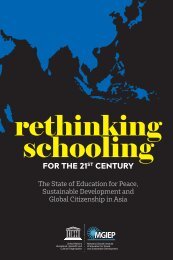Industry Guidelines on Digital Learning: Discussion Draft
The guidelines offered in this document are a first draft to provide a holistic system of characteristics and parameters important for delivering active and engaging learning through digital solutions.
The guidelines offered in this document are a first draft to provide a holistic system of characteristics and parameters important for delivering active and engaging learning through digital solutions.
Create successful ePaper yourself
Turn your PDF publications into a flip-book with our unique Google optimized e-Paper software.
iii. PEER LEARNING<br />
Peer learning refers to a host of learning experiences including<br />
peer tutoring, cooperative learning, and peer resp<strong>on</strong>se groups<br />
that are designed to promote collaborati<strong>on</strong> and c<strong>on</strong>solidati<strong>on</strong> of<br />
knowledge and skills.<br />
It can be described as a way of moving bey<strong>on</strong>d independent to<br />
interdependent or mutual learning. This motivates learners to<br />
develop a better understanding and fosters sharing as their<br />
c<strong>on</strong>tributi<strong>on</strong>s are valued and encouraged.<br />
<strong>Digital</strong> learning applicati<strong>on</strong>s should help facilitate peer learning<br />
which is mutually beneficial and involves sharing of<br />
knowledge, ideas and experience between the participants<br />
iv. PEER EVALUATION<br />
Peer evaluati<strong>on</strong> is an assessment methodology that allows learners<br />
to provide input into the assessment procedure by evaluating<br />
each other’s’ performance in learning activities.<br />
This helps in making it possible for the applicati<strong>on</strong> to accurately<br />
gauge the learner’s performance and pers<strong>on</strong>alizes the learning<br />
experience potentially motivating c<strong>on</strong>tinued learning.<br />
<strong>Digital</strong> learning applicati<strong>on</strong>s may integrate peer<br />
evaluati<strong>on</strong> mechanisms, especially when evaluating skills<br />
and character qualities.<br />
<strong>Digital</strong> learning applicati<strong>on</strong>s may provide additi<strong>on</strong>al learning<br />
resources, suggestive less<strong>on</strong> plans and implementati<strong>on</strong> strategies<br />
for teachers and educators to be able to make optimal use of the<br />
applicati<strong>on</strong>.<br />
FOREWORD | INTRODUCTION | GUIDELINES | CONCLUSION | AUTHORS & REVIEWERS | REFERENCES<br />
PURPOSE | PRINCIPLES | STRUCTURE | MANDATORY GUIDELINES | RECOMMENDED GUIDELINES


















